Scammer shuffles Apple out of 9,000 iPods
Posted by: shilpz in apples, gadget guru, ipod touch, scammer shuffles, technologyFor whatever reason, Apple's iPod ends up in the middle of quite a few crimes. The latest story, however, is even more extreme than usual. Nicholas Arthur Woodhams, a 23 year old from Kalamazoo, Michigan, was recently slapped upside the gord with federal charges of fraud and money laundering after he managed to con Apple into shipping him around 9,000 iPod shuffles. As the story goes, he managed to somehow correctly guess thousands of valid shuffle serial numbers and have replacements shipped to him; once they arrived, he sold them for less than MSRP to excited buyers, all while giving Apple a prepaid VISA number that would reject the charges after he failed to send back the nonexistent "original" shuffle. It's rather amazing to us that he was able to pull this off for so long without being noticed, but even if it works for awhile, we've learned yet again that crime doesn't pay. In fact, the feds have already seized a half million bucks from one brokerage account, some real estate and a trio of vehicles. Tragic, yeah?

Get rid of the pesky cord that normally comes with headphones and go wireless by using Sony’s lightweight Bluetooth 
Toshiba Japan announced a new portable DVD player today [JP], the SD-P93DTW, which is equipped with a One-Seg digital TV tuner. The device is Japan-only at this point. But Toshiba sells the SDP93S in the US, which is essentially the same player minus the TV tuner (the tuner is useless outside Japan and Brazil anyway). And Americans have to pay a lot less for their player. Japanese buyers will be set back a whopping $520, while the SDP93S costs just $180 at Amazon. The Japanese version is also equipped with an analogue TV tuner and supports SD/SDHC/microSD/micro SDHC cards but apart from these features (the American version supports SD cards only), it seems to be the same model: a swiveling 9-inch TFT LCD screen with 800×480 resolution, DivX support, JPEG viewer, virtual surround sound and built-in speakers. The SD-P93DTW will hit Japanese stores at the end of April.
The Coleman LED Quad Lantern splits into four lights
Posted by: shilpz in Coleman LED Quad, gadgetguru, lantern, technology, technology news
When camping with the whole family, it can present some slight lighting issues. There are of course always ways around that, but it usually means packing four different kinds of lights and plenty of flashlights as well as batteries. Well Coleman, being one of the better brand names for camping, has come up with a different solution. It offers one giant lantern that will give light in all directions for when you’re all sitting together, but an extra perk for when you go off in different directions.
The side panels, of which there are four, all snap off. They can work individually or all together once put back on the lantern. Each individual panel has a recharageable NiMH battery, those charge off of the eight D-cell batteries that are located within the base of the lantern. Those batteries can run the lantern all together for 72 hours, a full charge of the panel will give an hour of light per panel. Due to the frosted lens and wide-angle LED lights, it will give off light over a large area. You can purchase it on the Sears website for $69.99.
![]() The weather is warming up and we know that all you rich iPhoners will be busting out your sticks and hitting the fairway. Now golf is a sport aimed at those with disposable income so there are plenty of gadgets on the market for specialized purposes. Range finders, shot tracking etc. None of them will make you a better golfer but everyone tries them because they think you can buy a swing.
The weather is warming up and we know that all you rich iPhoners will be busting out your sticks and hitting the fairway. Now golf is a sport aimed at those with disposable income so there are plenty of gadgets on the market for specialized purposes. Range finders, shot tracking etc. None of them will make you a better golfer but everyone tries them because they think you can buy a swing.
Skip all the gimmick gadgetry and just grab your iPhone, there are a ton of great apps for all your golfing needs. For a list check out 10 Kick Ass Golf Apps ay mygolfspy. I was honestly surprised at all the oolness offered by the various apps so I’ll be loading up my iPhone for a few of these when I hit hit the links this spring. And, to answer the obvious question, there is no app that will drain the pool to clean up the Baby Ruth bar.
Atek Logio Secure Password Organizer Review
Posted by: shilpz in Atek Logio, gadgetguru, Organizer Review, Review, technology
Security is important to all of us and when it comes to technology our passwords are often a critical component. Everyone knows that our passwords are only as good as we make them. It is crucial that a password is not easy to guess. No names, birth dates, need to use both upper and lower case letters, numbers and special characters.
The problem is how do we remember them all because if you have a complex password written on a post-it hid under your keyboard, what good does that do. Personally, I have a lot of different passwords for different web applications and databases. The only reason I still use my decade old Palm V is because it has a reliable password application called Keyring. Maybe it is time for me to finally retire my Palm V.
Today I am reviewing the Atek Logio Secure Password Organizer. Let’s see how it stacks up as a password repository solution.
PRODUCT SPECIFICATIONS:
- Data protected by sophisticated AES encryption implementation
- Set up your own master passcode and change it whenever you want
- Store website names and/or addresses, user IDs, and passwords
- Store desktop logins, ATM and debit card pin codes, credit card numbers, frequent flyer program numbers, password and driver’s license numbers, etc.
- Holds over 200 records - no data loss if battery runs down
- Save your three favorite user IDs for easy entry in records
- Generate random passwords automatically or manually enter numbers, uppercase and lowercase letters, symbols, and punctuation marks
- Quick entry of special characters for Web and email addresses
- Go directly to records by pushing the number or letter at the beginning of the record you are looking for
- Audible button tones for easy operation
- Optional display of lost and found information
- User-configurable settings for button tone volume, screen contrast, and auto-off time
- Advanced navigation and editing functions for power users
- Available in two colors: black and white
- One year limited warranty

IN THE BOX:
- White Logio Secure Password Organizer
- White carrying pouch
- White lanyard
- Coin cell battery
- Lanyard safety instructions and installation manual
- User’s Manual
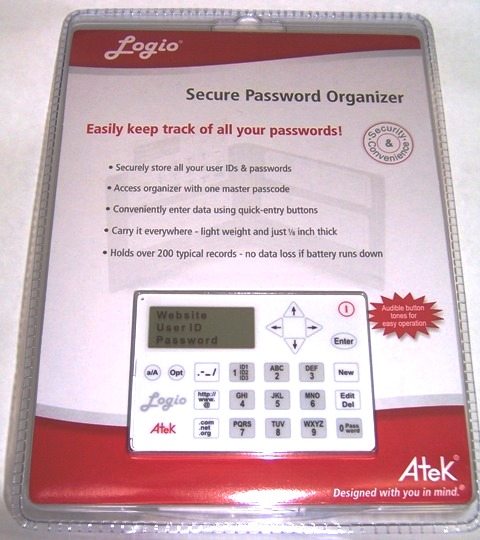
The device is nicely package in a compact, clear blister package. The packaging is rather difficult to get through, even though it has a perforated opening in the rear. If the device provides as much security as the blister pack, it will be a very good investment.
At first touch, the Logio Secure Password Organizer feels more like a cheap novelty item then a robust gadget. Roughly the size of a credit card and constructed of flimsy, thin plastic, it is very light but fails to pass the creak and crackle test on nearly every touch. I am not sure this unit will be able to survive much wear and tear.

The functional layout of the device is very straightforward, in that all the buttons are on the front-face of the device. Twenty-three buttons comprise all of the user options. The alpha-numeric keys are just like the ones on a standard phone. The number 2 button is also “ABC”, 3 is “DEF”……9 is “WXYZ”. This gives all the alpha-numeric options with ten buttons. The negative is it can take multiple presses for some letters. For instance, “S” and “Z” both require users to hit the button four times. To enter the “7″ or “9″ requires five times.
The alpha-numeric buttons are surrounded by miscellaneous buttons. Two of these buttons are dedicated for the routine text and symbols that you might need to track for web sites passwords, “http://, www., @” and “.com, .net, .org”. Added convenience for the user although I am not sure I would really need the “http://” as I tend to just record site information without the preface.
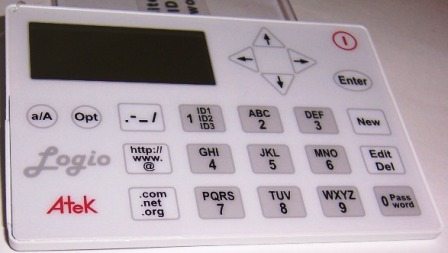
I inserted the CR2016 coin cell battery via the slide load mechanism located on the left side of the device and powered it up by pressing the power button in the upper right corner. Immediately I stepped back into time. Into the time of dot matrix computer screens. The screen lacks any backlight and I found that I had to adjust the contrast to the highest setting to see the display.


One of the first steps of the initial set-up is to establish a master password which is 8 to 15 characters in length and is only numbers, no letters. It is critical to remember this password because there is no method to reset and recover if you lose/forget it. I know this is for security purposes but users really need to make sure their master password is something they easily remember or the device can become worthless.
Other initial set-up steps include lost and found information (name & phone number), tone volume, auto-off time and contrast level. The set-up also provides users with the options of storing up to three commonly used user ids. So if you normally use “1CoolDude” as your username when creating an account, you can save that id and you will not have to type it in every time you create a new username/password account. That is pretty cool.
I selected ten accounts and decided to load them in. Unfortunately, that is where my disappointment started. Manipulating the keypad to enter account information is not easy, to say the least. I had difficulty, especially when I made a typing mistake. Not easy to fix. First you have to maneuver to the incorrect letter or number, once it is flashing you press the “Edit, Del” key. Not like your expectations from a standard keyboard operation.
I should have known that the Atek Logio Secure Password Organizer was not going to be as easy to operate as I had hoped when I noticed the user manual was 55 pages in length. YIKES!
To make it worse, the device would sporadically turn itself off. I thought it might be a bad battery, so I bought a new one and installed it but the failure mode persisted throughout the review. I never could determine the failure mode that caused it shut down but it definitely made it more difficult to complete the review.
The accessories include a leather carrying pouch with soft plush lining to protect the device. As I mentioned previously, touching this device makes you believe you need a Hummer to protect it from shattering into a million tiny pieces.
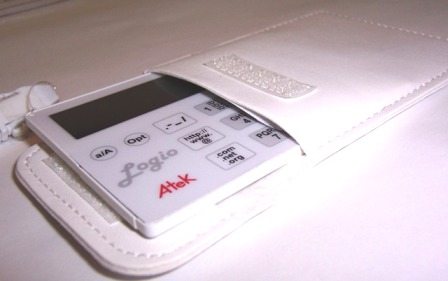
The included lanyard connects to the unit via what looks like fishing line pushed through a tiny pass-through in the upper left corner. Now I know that some fishing line can be very strong but it just looks not expensive and not durable.

In conclusion, the premise behind the Atek Logio Secure Password Organizer is sound and I am sure that there is a huge consumer market for a reliable tool to help manage passwords. The compact size, ability to store your 3 favorite usernames, not losing data when the battery is removed and dedicated buttons for commonly entered text are the biggest positives from the device.
Unfortunately there are some definite negatives that outweigh the positives. The biggest is probably the impression of inexpensive manufacturing. In other words, it feel cheap. There were times when I was using the keypad that I was concerned I might press too hard and shatter the unit into pieces. That might have been a factor in why the unit I utilized for this review kept sporadically shutting down. I might have pressed hard enough to break something internally.
I found it difficult to use (remember the user manual is 55 pages long) and the old school dot matrix display without any backlighting is horrible. Considering it all, I would not recommend the Atek Logio Secure Password Organizer as a password management solution. Looks like my Palm V will survive another day.
I remember first seeing the Zivio Boom Bluetooth wireless headset at the 2008 Macworld Expo and thinking that it looked pretty sexy, but I wasn’t sure about the practicality of the telescoping boom microphone. It’s now one year later and they’ve sent me one to review. Let’s take a closer look. Bluetooth Version 2.1 + EDR and Multipoint Zivio Bluetooth headset My first impression of the Zivio was that it looked very Apple-esqe with its Black and chrome design. I think it has a cool tech fashion style with crisp edges and modern geometric touches in the buttons and LEDs. The outside surface has a slightly rubberized texture that feels soft to the touch. There are three buttons on the outside. The one closest to the back edge is the call answer / end button. This button (called the Joby button) has a circular pattern of LEDs that shows the status of the battery and pairing mode. It will also blink every 5 seconds to indicate that it is powered on. The + and - buttons allow you to adjust the volume. Pressing both volume buttons at the same time will toggle mute on and off. All three buttons have good tactile feedback. The earphone is located on the other side. It can swivel on its base to allow for a more customized fit. The power button and charging connector are located on the back end of the headset. The headset charges through a special USB cable that can be plugged into your computer, or into the included AC adapter. The Joby button will glow Red while the headset is charging. When charging is completed, the Joby button will glow Green. The main unique feature of the Zivio is the telescoping boom microphone. The boom is relatively easy to extend and collapse. I do have some fear that the boom could break after repeated use. It is made from really thin metal tubes. Although you can use this headset without extending the boom, the sound quality (for people on the other end of your conversations) will be better when you take advantage of this feature. Zivio offers several ways to wear this headset. They include three gel style ear pieces that will allow you to quickly insert and remote the headset from your ear. These ear pieces are soft and pretty comfortable. If you prefer using an ear hook, Zivio includes a magnetic ear hook and a snap on adapter that is used with what they call mushroom style ear pieces. The adapter snaps on the ear piece… Then a mushroom ear piece installs over the adapter. Lastly, the magnet ear hook is placed on the metal inside surface of the headset. Since the ear hook is magnetic, you can slide it around where ever works best for you. Here you see me wearing the Zivio with and without the ear hook. I actually prefer not to use the hook with this headset. For me, it takes too long to put on this headset when I’m using the hook. I’ve also pulled the magnetic hook off the headset when I remove it from my ear. Although it’s a cool idea, I’m wondering how many people would really use it on a regular basis. I have had no problems using this headset with a Nokia N85. It paired easily and the audio quality on my side of the calls was outstanding. When calls come in, the ring tone set on the phone plays through the Zivio headset. It also worked well for voice dialing. Accessing the buttons while wearing the headset is pretty easy, but I do wish that they weren’t quite so flat, so that you could feel them through a thin glove. It is Winter right now, so I’m always wearing gloves while driving. Ok, time for the sound tests! Below are several audio clips of the Zivio Boom headset in action. This will give you an idea of what it sounds like to receive a call from someone using this headset. I used the free voicemail / fax service from K7.net for these tests. I signed up for a free account, got a phonenumber and called it using a Nokia N85 while using the Zivio Boom headset. The resulting voicemails are then emailed to you. Pretty nifty! At test time, the phone had full signal strength. Click to listen. zivio-boom-outside (108k .WAV file) zivio-boom-inside (96k .WAV file) zivio-boom-car (68k .WAV file) It’s pretty apparent though these sound bites that the headset sounds much better on the caller’s side of the conversation when the boom is extended. When it is not extended, the audio sound muffled and muddy. Other than wind noise, the headset does well with canceling background noises while driving (road noise, engine noise and radio). I like the Zivio Boom Bluetooth headset because it’s easy to use, easy to charge, looks pretty nice, is comfortable to wear and has good sound quality on both sides of a conversation. That said, I haven’t made up my mind yet if the extendable boom is a great feature, or just a hassle. I’m all about gadgets being fast and easy. So if I have to pick up the headset, extend the boom and then put it on, that’s one extra step that I would not have to do with a regular headset. Am I being too picky? Yeah probably… What do you think? Would you use a Bluetooth headset with an extendable boom?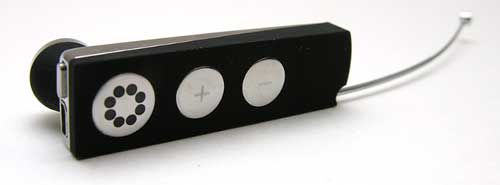
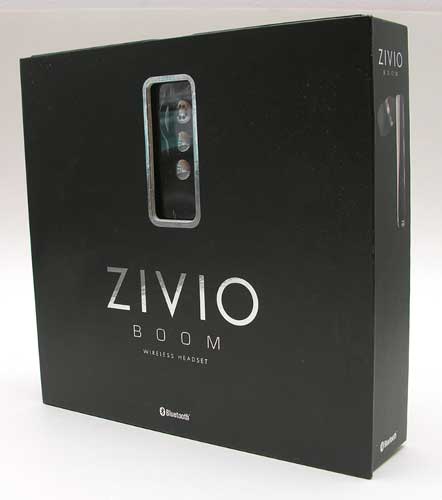
Hardware Specifications
10 m (33 ft) range between phone and headset
Talk time: 10 hours
Standby time: 200 hours
Built-in rechargeable battery
Charging via power adapter or any other standard USB compliant charging device
Power adapter simultaneously charges two USB devices
Size: 53.5 x 15 x 7 mm
Weight: 13 g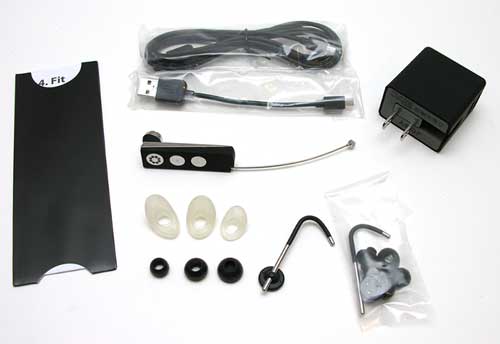
Package Contents
Dual-USB wall charger
2 × USB charging cables
Quick-start pocket guide
Illustrated Manual
2 × magnetic ear loops
3 × scoop style earpieces
6 × mushroom style earpieces
2 × mushroom connectors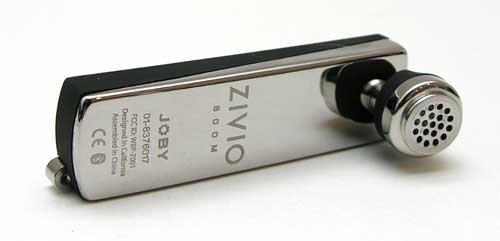
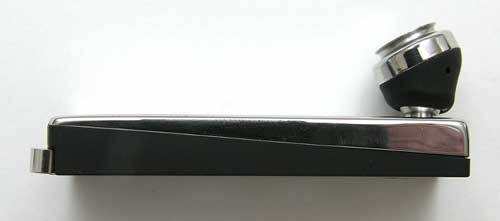
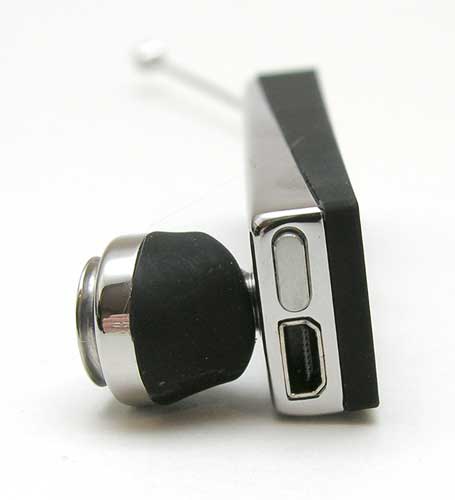
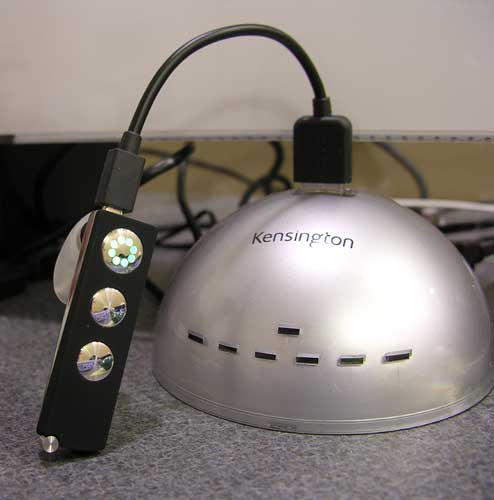




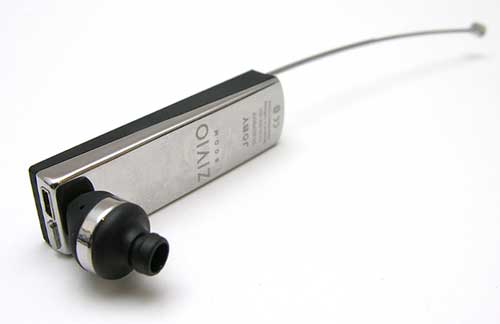
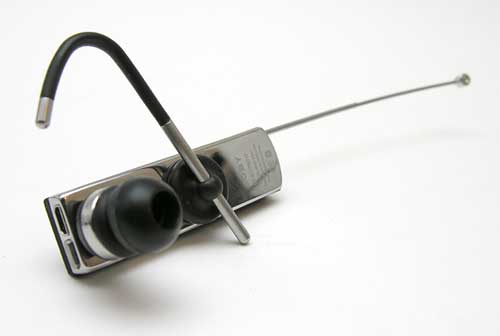

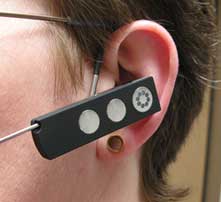
22 inch Digital Photo Frame
Posted by: shilpz in 22 inch, 9MP Digital, digital photo frame, gadget guru, photo frame, technology, technology news
How would you like a 22″ widescreen wireless digital photo frame that can display up to 150,000 images on its 1680 x 1050 LCD screen and hang on your wall? You can even choose from different frame styles made of wood, metal, and leather. Sounds pretty sweet right? But would you pay $999 for it? The folks at Photovu sure hope so.
Bluetooth Vibrating Bracelet
Posted by: shilpz in blue tooth vibrating braclet, braclet, gadgetguru, technology, technology news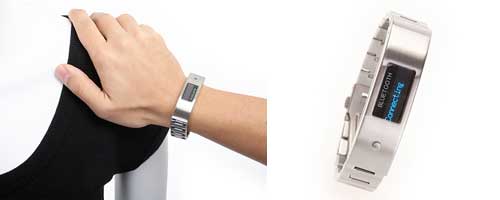
This Bluetooth bracelet from Brando won’t let you miss a call when your phone is buried at the bottom of your purse. It vibrates when a call comes in and will let you answer or reject the call. It also has a Link Loss Alert Function that will cause the bracelet to vibrate when your mobile phon,e is more than 5 Meters apart from you.

Top Gear is out to show the world that you don’t need a brand new hybrid car with a $25k price tag to be eco friendly. Their goal: Build a car that can get 70 mpg for only $7,000 and can hit 60 MPH in under 7 seconds. It’s called…The Sipster.
The Top Gear.com American team choose a 1981 VW Rabbit. Classy and classic that Volkswagen is. The project just started but we wish them the best of luck out smarting a Toyota Prius while keeping the price in a recession friendly range. The blog will be updated with pics and the progress. We’ll be keeping a close on this one.
Asus Getting Rid of 8.9-inch Netbooks in 2009
Posted by: shilpz in 8.9, Asus, gadgetguru, laptop, notebook, technology, technology newsIf you like 8.9-inch screens, you might want to get one now. Asus has said that it'll be phasing out that size in 2009, since 10-inch models are dominating the market.
According to Digitimes, Benson Lin, president of Asustek Computer's Asia-Pacific division said that 10-inch models account for 95% of the company's sales. 7-inch models make up the other 5%.
To be honest, I'm surprised 8.9-inches is not a popular option. Maybe I'm just weird, but I always though that screen size hit the sweet spot between fitting into a purse and still having a somewhat usable keyboard.
Microsoft Zune 120GB
Posted by: shilpz in 120gb, gadgetguru, microsoftzune, mp3 player, technology, technology news, zune
Microsoft’s fabled Zune line has done a lot of growing up over the years. From the first-gen 30GB player that we scorned back in 2006 to the 8GB model we warmed up to 2007, Microsoft has continually been fine tuning its line of media players to deal with the crush of criticism they’ve met on the open market. That refinement reaches its pinnacle with the 80GB and 120GB players, which are both the largest and most capable Microsoft has ever produced. But are they ready to run alongside Apple’s class-leading iPod yet?
OCZ expands Alchemy line with Illuminati backlit keyboard
Posted by: shilpz in alchemy line, gadgetguru, illuminati, keybooard, OCZ, technology, technology newsVuzix's $249.95 iWear AV310 Widescreen eyewear now shipping globally
Posted by: shilpz in AV310, eye wear, gadgetguru, iwear, technology, technology news
ASUS begins shipping ultra-longevous Eee PC 1000HE
Posted by: shilpz in Asus, Eee pc 100 he, gadgetguru, laptop, technology, technology news
You call it an abomination. I call it a miracle of science!
Not being geniuses, most people look at the Omnitech 16878-US and see a solid GPS device with an ample 4.3” LCD TFT touchscreen, text-to-speech directions in three languages, and a 1GB SD card preloaded with Navteq maps of the lower 48. Imprisoned in the straitjacket of conventional thinking, their vision extends no further than its QuickNav button, which calculates directions back home from wherever you are, with just one touch. They see its 1.5 million points of interest, but overlook many more interesting possibilities. And on a day like today, they swoon for the ridiculously low price. Such is the mediocre mind, that can see only what is in front of its face – and even then its sight is befogged.
But I, on the other hand, being endowed with gifts of the intellect unknown to all but the longest-running Tic Tac Dough champions, I see more. I see a device whose WinCE operating system makes it a blank canvas upon which I will hack my masterpiece! I have devoted my life to a detailed study of how to mod this device, as explained on secret hidden arcane message boards (registration required). Adding new maps? Points of interest? Preferred software from other GPS devices? Mere child’s play. Changing the text-to-speech voice, or making it say “Turn left at next corner, oh peerless scientific giant of your time”? A mere lark. Transforming it into an MP3 or video player? Well, you might have to add a couple of other Windows files, or whatever – but nothing a genius like me can’t handle!
You say it is a crime against technology for me to twist this Omnitech 16878-US into something different, something better, something its makers never intended? I say it is you who are criminally negligent for ignoring this magnificent device’s full potential! Such might, such elegance is wasted simply telling you how to get to your hotel off the highway outside of Akron! I will mod and hack the Omnitech 16878-US, and any who stand in my way will need directions only to the cemetery!
Warranty: 1 Year Omnitech
Authorized for SquareTrade Extended WarrantyFeatures:
- Easy to use – large icons with bright screen display
- 4.3inch TFT LCD
- User friendly touchscreen
- Text-to-speech announces directions and street names
- One-touch QuickNav button, program in the address to your home or office. Then tap the home button to automatically have it route to that address from where ever you are
- Dual processors calculate routes fast, especially alternate routes
- 2d, 3d, day or night views available
- Multilingual voice prompts in English, French, and Spanish
- 1.5 million point of intrest
- Preloaded Navteq maps of the 48 United States stored on a 1GB SD card
- 1.5 million points of interest pre loaded
In the box:
- Omnitech 16878-US GPS
- Universal Suction Mount
- Cigarette Lighter Adapter
- 1GB SD Card
- Users Manual on CD
- Quick Start Guide
SyncBook iPhone Application Review
Posted by: shilpz in aaplication, iphone, Review, sync book, technology, technology newsWhile much of what I need is on the Web in one form or another, there are times I need to access information when there is no network available. This has been, until recently, one of the few real issues I have had with the iPhone: notes taken on my computer can’t be shared easily with my iPhone and vice-versa. Recently, I’ve been using SyncBook, an iPhone app that syncs with my Mac via text files over a local network connection.
There have recently been several different apps released that come at this issue from various angles. I have tried a few, and have come to rely on SyncBook for my needs, for reasons explained below. (A word for all the Windows and Linux folks who will complain that I don’t mention their platform - this is not my decision. The developer is not interested in the Windows market, and has no plans for creating a client there. While this is a negative for many, it holds no barrier to entry to me, so will only slightly come to bear on my final grade. Your mileage, as they say, may vary.)
SyncBook is delivered as a 1 MB app downloaded to your Mac. The iPhone app is purchased from the iTunes Store’s AppStore area at http://phobos.apple.com/WebObjects/MZStore.woa/wa/viewSoftware?id=290800829&mt=8.
I used Palm devices for most of the last decade. While I was a Newton user first (and still would be if the right device/software existed), the Palm III won me over by being in my shirt pocket whenever I needed it. Writing notes and having them sync with my Mac was quick and clean, and gave me all the data I could want in the palm of my hand. I moved up to Documents to Go during the beta test of version 1, and stayed there until DataViz dropped the ball by not providing compatibility with the MissingSync when this became the only way to sync a Mac. I moved to Mark/Space’s excellent Notebook included with that product instead. I was a happy Palm user, having had the same Tungsten|C for over three years when, about a month before iPhone Launch Day in July of 2007, several folks in my office started discussing the looming Launch with me. After a few more such conversations, I decided to get an iPhone and converge my phone and handheld.
(apology/aside for those who have yet to drink the Apple/iPhone Kool-aide)
I have never, from the first time I held that iPhone in my hands, regretted it. I live in a 3G area, my company is very Mac-oriented and many folks use iPhones. Plus, as a member of an area Mac User group, I have a lot of other friends who are also in that camp. In the last year, however, I’ve noticed that everyone everywhere that isn’t a button-down business person or lawyer seems to be toting an iPhone: mothers, pastors, chemists, architects - everyone. I see them at church, in stores, in restaurants, and on the street. Students, musicians, baristas - it’s strange to me that these things are so prominent in my area. (I live in central North Carolina, in an area known as the Research Triangle, where we have loads of high-tech companies, in addition to three large research universities: Duke University, University of NC at Chapel Hill, and NC State University. This may account for the large geek cred of the area.) For these reasons, I assume most of these people are not “Apple fanboys” but True Believers®. So, that’s my bias, but you can see where it comes from.
(end aside)
Here’s how this pair of apps works: Download the Mac version and install it. This will create a folder for saving text files in your Documents folder. Purchase the iPhone app ($3.99) and sync. In order to sync these two, you’ll need to either be on the same wireless network, or create a wireless network on your Mac for the iPhone to connect to. (How to do this is beyond the scope of this review, but it’s trivial. If you’re reading this, you’re enough of a nerd to know how to do this or to have friends who do.)
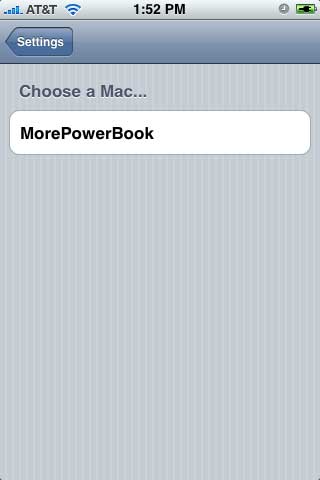
Run the app on your Mac, and in the iPhone app, click the small gear on the bottom left. This is the “Settings” icon. In Settings, the first item is Syncing. Click to search for your Mac. Once you see it, click to select it and go back to the main window. Now, whenever you want to sync, click the circular arrow on the bottom left of the screen. New notes you create on the iPhone will show up in the list on your Mac, and new text files you place in the folder the Mac app created will show up on your iPhone. (As with any syncing program, changing both versions before syncing will cause data confusion. SyncBook realizes this and does warn you, but how you get out of it is up to you, because you know which changes are more important. It’s easy enough to select all and copy on the Mac, sync, then paste in the copy and compare, but it’s so fast to sync, you shouldn’t let yourself get into this situation.)
While you don’t have to, the latest version of SyncBook Mac has a button to “Add Note” that creates a note in the Notes folder, already added to the list and ready to update. I’ve been using this to create a notes with no problem.
Looking at the Mac window, you can see small color labels on some of the icons. There are unlimited categories you can add to and name as you feel, and a select few colors (helpfully named “Red”, “Orange”, “Green” and so forth) that you can optionally assign to your documents. This can only be done on the iPhone app, but shows up on the Mac at the next sync.
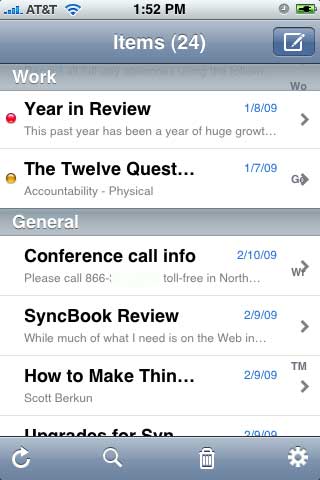
For the money, it’s one of the cheapest and best notes syncing apps I’ve seen. There are freebies that aren’t as powerful or require an odd format on the Mac, or require syncing through a web service, rather than directly. Evernote, the most notable challenger (and one I had been using for a while before finding SyncBook) is one such alternate. I’ll post another review of it later, but, briefly, it has a Mac client (and one for Windows), an iPhone app, and a web app, where you create a login. All data is always synced to the web first, then sent out to other clients. This works wonderfully, until you want to sync something really secure that you don’t want anyone, anywhere, to accidentally have access to - medical records, business info, financial records, whatever. With SyncBook, I can be riding on a train with no network access, fire up my Mac’s ad hoc access point, find that network on my iPhone, and sync everything immediately, securely, and with no worry about network connection speed. (I had only thought this was an issue, thinking no one would really want to look at things posted to a note account, when I saw a tweet from @EverNote commenting on a picture of a whiteboard written in Chinese. They actually sent a link to everyone on their list linking to a user’s data, and admitted that they had no idea what it said. It could have been his phone number, or plans for a new internet device, or the timetable for their bid to world domination. In any case, it was not Evernote’s right to post it. But that’s the choice you have to make when using a web service. SyncBook will never expose your data to anything beyond your local wireless LAN. If you have something you want to keep private, private it shall remain.
There are a few bumps on this road to happiness. For one, the Mac app has almost no control, other than creating, removing and showing notes. You can’t create or edit categories, sort, change labels, or anything else on the Mac. On the iPhone, you can move categories into any order you choose, add and edit categories and colors, and change font shape/size/color globally. There is a search feature on the iPhone app, but other than telling you a certain word or phrase appears in a note, it doesn’t help. (Granted, with no selection feature for text available in the iPhoneOS, this can be partially forgiven. But they could offer to find and move the cursor to the beginning of the target phrase.) Syncing via wireless is great if you have a MacBook of some flavor, but if your machine is the base-level MacPro (the only Macs that don’t ship with a built-in wireless card), you’ll have to figure out another option. One editing snag that continues to irritate me on the iPhone: when I’m editing, or even if I’m scrolling and happen to hold my finger still for too long, it switches to Edit mode, and I lose the scroll-by-flicking that is at the heart of the iPhone. I’d rather be in browse mode until I decide to edit, hit the button and go. Then I’d like to turn off the editing and go back to scrolling, without having to close the document and open it back up.
For me personally, this app combo is a solid 4 out of 5 stars. I don’t create huge notes that need internal searching, and I don’t need Windows. Sorting on the Mac and a slightly more robust viewing/sorting/categorizing feature would add a lot, as would options such as an “edit” button, but it’s so functional for me currently (in my minimalist way) that this cluster of missing features is only one star.
For many others, however, I’d have to rate it 3 or 3.5 out of 5 stars, since Windows compatibility is important, and some may be after more features. While you can’t have the same pricing and distribution structure on Mac or Windows apps that you do with iPhone apps, having an advanced “syncs with Windows” version that only added that capability and cost more but provided a “free” Windows app download would be a great feature for those callous Philistines who insist on staying with the Devil’s OS. (I’m kidding, just kidding. Stop writing hate mail!) Or charge for the Windows version, since he’s probably going to have to hire that out.
EA Bringing Dead Space Prequel to The Wii
Posted by: shilpz in Dead Space Extraction, gadget guru, PlayStation 3, technology, technology news, Xbox 360EA has announced Dead Space Extraction, a prequel to its sci-fi/horror game Dead Space...and it's being built exclusively for the Wii.
Electronic Arts has announced it is developing a prequel to its scifi/horror game Dead Space called Dead Space Extraction—and where the original Dead Space is available for the Xbox 360, PlayStation 3, and PC, Dead Space Extraction is being developed for the Nintendo Wii.
"We could not be more excited to extend Dead Space into an experience exclusive to the Wii," said EA Redwood Shores VP and general manager Glen Schofield, in a statement. "Nintendo has a wonderful history in the horror genre and we are thrilled to build on that tradition."
Promising all the blood, gore, and "intensity" Dead Space fans are used to, the prequel will tell the story of a group of space colonists who try to escape from a terrible infection spreading through a mining colony. The game will introduce new characters, weapons, enemies, and puzzles for players to solve, as well as enable cooperative multiplayer action. EA also promises Dead Space Extraction will leverage the Wii's unique motion-sensitive controller with frenzied first-person action.
The announcement falls in line with EA's new emphasis on developing games for the Nintendo Wiim, citing lower development costs to bring games to the platform—according to EA's John Riccitiello, developing standard-definition games for the Wii can cost as little as a third to a fourth of the cost of developing a title for high-definition consoles. EA's moves will also likely diversity the range of titles for the Wii, broadening the platform to include titles like Dead Space Extraction aimed at mature, hardcore gamers, rather than casual and non-traditional gamers, or children.
Apple makes online music lessons easy with GarageBand
Posted by: shilpz in apple, apple news, online music, technology, technology newsOnly one problem: Most got it wrong.
"They do a nice job," says the singer/songwriter, but "most don't realize it's in open D tuning and has totally different chords."
Now Caillat gets to show how it's really done. She is one of nine artists offering video music lessons at $4.99 a pop via Apple's GarageBand, the music-editing software bundled into its iLife suite of programs. Among others, John Fogerty teaches Proud Mary and Norah Jones shows you how to perform Thinking About You.
Many sites offer video music lessons now. A year ago, iVideosongs was launched with artist tutorials from Graham Nash, John Oates and Rolling Stones keyboardist Chuck Leavell. And there are thousands of free instructional videos on YouTube produced by young guitarists and teachers. Some even feature well-known performers such as Paul McCartney, Police bandmate Andy Summers and Queen guitarist Brian May. Longtime guitar-maker Gibson even devotes a page of its website to the YouTube lessons.
Apple's high profile — and heavy promotion of the video lessons within its 250 retail stores — brings the idea of learning music online to higher prominence. "It's a fantastic idea, and I hope they do more," says British guitarist Justin Sandercoe, who offers free video lessons at Justinguitar.com. "The idea you can have the guitar lesson with the actual artist who wrote the song is terrific. Now, a great artist may not be a great teacher — they won't be familiar with the act of teaching — but the fact is, it's Sting teaching you Roxanne."
A ministudio
GarageBand is a minirecording studio tool that often gets overlooked by Apple computer owners. As part of an overhaul for the iLife '09 program suite (free with new Macs, or $79), Apple added an instructional component to capitalize on renewed interest in playing music spawned by popular "rock band" video games.
"There's this huge problem that hasn't been attacked yet," says Phil Schiller, Apple senior vice president. "Finding a new way to teach music, from your personal computer."
He says the YouTube instructional clips — his kids watch them — "don't attempt to solve the whole problem: how to properly learn to play."
Apple has a guy named Tim (it won't reveal his last name) offering free lessons on playing guitar and piano. For $4.99, artists such as Sarah McLachlan and Ben Folds show you where to put your hands on the guitar or piano keyboard and what key they like to play the song in. They also tell you about how it came to be written.
But if you just want to find out what the chords are to AC/DC's Highway to Hell, it's all there on YouTube for free.
"This is how kids learn music now," says Stutz Wimmer, an Atlanta-area high school music teacher. In a bygone era, teens might listen to a song over and over again to figure it out. Now, "Somebody shows them the chords online."
The YouTube instructors range from professional guitarists such as Sandercoe to young teens in their bedrooms with a Stratocaster.
Edison Mellor-Goldman, 17, a Los Angeles-area high school student, likes to go home from school and make video tutorials using his iMac computer's built-in webcam. "When you teach someone one-on-one, that's great," he says. "But when you put it on YouTube and hear from 100,000 people around the world that 'you helped me' and get such a massive amount of feedback, that's really something."
He's made 33 videos. His most popular — how to play Jason Mraz's I'm Yours— has been viewed 200,000 times on YouTube.
Sandercoe began offering video lessons in 2007 as a way to attract new students. His lesson on how to play Guns 'N Roses' Sweet Child o' Mine has picked up more than 2 million views. His site attracts 600,000 viewers a month. "People can share their common love of something online. It's a fantastic resource," he says. He offers instructional DVDs for sale and asks for contributions. He says he averages about $100 a week.
Most of the lessons found on YouTube are by young teens. Many are imprecise, says Tim Huffman, CEO of Atlanta-based iVideosongs. "You get what you pay for. We offer multiple camera angles, high-definition video and accuracy."
Accessing lessons
Competing with Apple isn't easy — especially when he charges twice as much for artist lessons: $9.95 — but he says he has a few advantages. You can make purchases at the iVideosongs site or via Amazon downloads. The company also offers instructional podcasts (how to play slide guitar, the piano, etc.) at iTunes.
Apple does not offer stand-alone purchases of its copy-protected video lessons at iTunes. The only way to see Sting demonstrate Roxanne is by using a newer Mac with GarageBand.
Joe Lamond, president of the National Association of Music Merchants, a trade group for music stores (where most guitar lessons are held), says the growth of online video lessons has paid off with more-attentive students. Guitar sales — even in a recession — were up 3% in 2008, he says. He credits the Internet and video games.
Unibind Photos and Sounds Puts Audio on your Photo Album
Posted by: shilpz in gadgetguru, Photo Album, technology, technology news, Unibind PhotoWe have reported on the Unibind’s Photobook Creator before, and I seem to recall saying in that review that I would probably report on Unibind again. Sure enough, I have just heard of a brand-new development that Unibind is working on. Unibind’s Photos N Sounds is “the first photo book that allows anyone to record a personalized voice message”. The recording apparatus is on the cover, and it works by hitting a record button and saying the message or music. If the user is satisfied with the message, then he or she rips off a tab to make the audio file permanent. This is perfect for scrapbookers who want to have a personalized message attached to their scrapbooking album. This can also work for businesses who want to put audio to their marketing album/brochures. In addition to the personalized message, Photos N Sounds can play popular theme songs like Christmas carols or the “Happy Birthday” song. I have a little suggestion for Unibind: make it so the user can download an MP3 via USB. I’m sure that Unibind has already thought of that, and I’m certain it is probably more difficult than it sounds. Otherwise, that technology would be out by now.
Categories
- .laptop battery (1)
- ‘Billoo Barber (1)
- 'Slumdog Millionaire (5)
- “Melissa (1)
- “Starburst iPod”music gadget (1)
- 1.86ghz (1)
- 10 megapixel (1)
- 10" Aspire One (1)
- 120gb (1)
- 12megapixels (1)
- 2 million (1)
- 20 million (1)
- 20 ways (1)
- 2009 oscar (1)
- 2009 Sports Illustrated (2)
- 2010 (1)
- 2010 911 GT3 (1)
- 2010 Porsche 911 GT3 (1)
- 2010911Gt3 (1)
- 2010Porsche911Gt3 (1)
- 2011mini crossover (1)
- 22 inch (1)
- 245 runs (1)
- 2mn (1)
- 2pack (1)
- 3 Walkman Phone (1)
- 3GNC10 (1)
- 3GSM (1)
- 3GSM 2009 (1)
- 4 million (1)
- 50 Cent (1)
- 7 (1)
- 8 megapixel (1)
- 8 million (1)
- 8 oscar (1)
- 8.9 (1)
- 81 oscar awards (9)
- 9MP Digital (1)
- 9MP Digital Camera (2)
- A.R rehman (4)
- aap ka surror (1)
- aaplication (1)
- Abandon Gig (1)
- Abhishek (6)
- academy awards (5)
- academy awards2009 (1)
- acer (3)
- acer ships (1)
- adnan wife (1)
- adobe (1)
- ads (2)
- adsense (1)
- advertising social nettworl (1)
- affluence (1)
- AGAINST ALL ODDS (1)
- Aigo's "Jigsaw (1)
- airport (1)
- Aishwarya Rai Bachchan (5)
- AKKI (1)
- akon (1)
- Akshay Kumar (1)
- album leak (1)
- album of year (1)
- alchemy line (1)
- Aline Nakashima (1)
- Alleged Criminal Threat (1)
- Allen Stanford (1)
- Allen Stanford charged (1)
- Amanda Seyfried (1)
- amazon (1)
- AMD (1)
- america (3)
- american idol (3)
- AMEX Digital's SR-7 (1)
- amiah (1)
- amir khan (2)
- amitabh (1)
- amitabh bacchan (5)
- amitabh signature (1)
- Amy Adams (1)
- Amy Winehouse (5)
- ANDROID (1)
- Angelina jolie (11)
- Anil Kapoor (1)
- anna faris (1)
- anne french roll on (1)
- ANNOYANCES (1)
- apex court (2)
- APN contest (1)
- apologizes (1)
- apolpogy (1)
- app store (3)
- apple (9)
- apple news (2)
- apple store (1)
- apples (1)
- application launcher (1)
- application news (10)
- apps (5)
- Aquarium (1)
- Art (1)
- aspire (1)
- aspire one 10 (1)
- assault victim (1)
- Asus (3)
- Asus Eee 1000HE (1)
- Atek Logio (1)
- atlanta (1)
- Attacks Boyfriend (1)
- aussies (1)
- austrailia (1)
- AV310 (1)
- awards. (6)
- b (1)
- babes (1)
- baby photos (1)
- bankable (1)
- banning (1)
- Bar Rafael (1)
- BART signs (1)
- BCCI awards (1)
- beach resorts (1)
- BELT (1)
- best actor (1)
- best actress (2)
- best director nominess (2)
- best picture (1)
- beyonce (3)
- big b (2)
- big band theory (1)
- bike (1)
- billu barbar (1)
- billu barber songs (2)
- bipasha basu (1)
- black (1)
- black dress (1)
- black variant (1)
- blackberry (2)
- blender india (1)
- blog tools (2)
- blog war (1)
- blogger (2)
- blogger updates (1)
- blogging (2)
- blogging tools (1)
- blogspot (1)
- blue tooth (1)
- blue tooth vibrating braclet (1)
- Bluetooth (1)
- Bluetooth Car Kit Review (2)
- bo (1)
- bobby (1)
- bollywod (55)
- bollywood (28)
- bollywood awards.redcarpets (2)
- bollywood beauty (3)
- bollywood birthday (2)
- bollywood celebrity (84)
- bollywood event (39)
- bollywood gossips (45)
- Bollywood Movie Reviews (4)
- bollywood movies (23)
- bollywood music (4)
- bollywood news (53)
- bollywood photos (1)
- bollywood songs (1)
- bond gril (1)
- booby moon (1)
- box office (1)
- Box Office Review (1)
- box set (1)
- boys night (1)
- braclet (1)
- brad pitt (6)
- bravia (1)
- breville cafe (1)
- Britney Spears (4)
- browser (1)
- Buy Palm Pre (1)
- calfeed (1)
- callpod (1)
- camedn (1)
- cameraphone (1)
- can do better (1)
- cancer (1)
- candobetter (1)
- canon10 cameras (1)
- car news (1)
- car technology (9)
- cars (13)
- cars event (1)
- cars evnt (4)
- casio exlim (1)
- Caudalie Moisturizing Cream (1)
- celebrity (9)
- celebrity news (3)
- celebrity style (1)
- celina (1)
- celina jatley (2)
- cellphone (33)
- CES 2009 (1)
- Chanel Show (1)
- child abuse (1)
- china (1)
- Chris Brown (8)
- Chris Martin's (1)
- chris pratt (1)
- Christian Bale's (1)
- chryster (1)
- circa (1)
- cisco (1)
- City Hotels (3)
- claims (1)
- CliqCliq (1)
- close down (1)
- cluring stutter (1)
- cofeedregs (1)
- Coleman LED Quad (1)
- Colibri pico projector (1)
- coloring (1)
- compuetr technology (1)
- condoms (1)
- Construction System (1)
- contact lens (1)
- copycar (1)
- copyright (2)
- coral lakes (1)
- cosmetics (1)
- costly music video (1)
- Cover Model (1)
- coveroo (1)
- Crackulous (1)
- craling site (1)
- cricket (7)
- cricket news (8)
- crown of bollywood (1)
- cruise (2)
- Cute EV "Sporty" (1)
- Cyber-shot Cameras (1)
- Cynthia Nixon (1)
- czarine style (1)
- daily article (1)
- dakota (1)
- Danish speakers (2)
- date a girl (1)
- dating (1)
- Davos (1)
- Dead Space Extraction (1)
- deal (1)
- Deal of the day (15)
- Deepika Padukone (3)
- Delhi 6 (4)
- delhi 6 premiere (1)
- Delhi 6 reviews (2)
- delhi6 (3)
- delhi6 songs (1)
- dell (5)
- DELL ANDROID PHONE (1)
- Dell Inspiron Mini 9 (1)
- dell mini9 (1)
- dell products (1)
- DELL SMARTPHONE (1)
- dell softwares (4)
- dellproducts (1)
- designer (2)
- dev aptel (1)
- DGA awards (1)
- Dhoni (2)
- digital photo frame (1)
- dino morea (1)
- dish networks (1)
- disney star (1)
- Displays (1)
- dolly parton (1)
- dream works (1)
- dresses (1)
- Drive Cordless Power Wrench (1)
- driving (1)
- driving lessons (1)
- DROPBOX (1)
- dsiney (1)
- DTVPAL (1)
- Dustin Hoffman (1)
- DVR (1)
- Dynaudio's (2)
- E350 (1)
- E550 (1)
- Eclipse (1)
- economy (1)
- economy news (1)
- ecosteal (1)
- ECW Departure (1)
- Eee pc 100 he (1)
- electric car (1)
- electronic gadget (1)
- Elimination Chamber Matches (1)
- Elisabeth Hasselbeck (1)
- emily blunt (1)
- eminem (1)
- Emotional Grammy (1)
- Emraan (1)
- Emraan Hashmi (1)
- engagement ring (1)
- EOS 5D Mark I (1)
- estee lauder (1)
- european children (1)
- Eva Mendes (1)
- Evan Rachel (1)
- event (2)
- events (2)
- expresso maker (1)
- eye wear (1)
- F200EXR (1)
- face book privacy (2)
- facebook (35)
- facebook 5 years (2)
- facebook apps (7)
- facebook connect (2)
- Facebook Design (1)
- facebook evolution (1)
- facebook news (35)
- facebook pyramid (1)
- facebook status (2)
- Facebook U.K (1)
- facebook updates (18)
- facebookopenid (1)
- fashion (4)
- fashion event (2)
- fashion news (2)
- fashion shows (1)
- fashion week (2)
- fashoin event (2)
- fastest growing (1)
- fatal brain injury (1)
- FeRAM (1)
- Fernanda Motta (1)
- Ferry (1)
- FICCI (1)
- FICCI awards (1)
- fido (1)
- fight (1)
- FILE SYNCHRONIZATION (1)
- final 36 (1)
- fingerprints (1)
- Fix (1)
- FLASH DRIVES (1)
- FLASHDRIVE (1)
- Flexeiras (1)
- flowercomposition (1)
- footballer (1)
- ford cars (1)
- Ford's ECOnetic Fiesta (1)
- freepc calls (1)
- Freida Pinto (5)
- freido pinto (3)
- french (1)
- fuijiflim (1)
- Fujifilm’s (3)
- funny gadget (1)
- future eyes (1)
- gadget guru (52)
- gadgetguru (31)
- games (2)
- gaming (1)
- garrity8 led (1)
- gauri khan (1)
- gautam kapoor (1)
- geneva (1)
- geneva 2009 (1)
- geneva motor show (1)
- Geneva2009 (1)
- georgia (1)
- ghalib (1)
- gilty couture (1)
- girl cheers (1)
- girls (1)
- Gitanjali Luxury Style Fest (2)
- gmail (6)
- GMail Filters (1)
- gmailupdates (2)
- goa (1)
- goldtennis racquet (1)
- golf apps (1)
- google (36)
- google adword (1)
- google adwords (1)
- google calender (1)
- google crawling (1)
- google crome (1)
- google earth (5)
- google earth updates (1)
- google earth5 (2)
- google japan (1)
- Google Malware Results (1)
- google map (4)
- google news (23)
- Google PowerMeter (1)
- google syncs (1)
- google tools (1)
- google updates (16)
- google.google adsense (1)
- Googlebot (1)
- gps (1)
- Grammy (1)
- grammy awards (12)
- grammy awards2009 (11)
- grammy gift lunge (1)
- Grammy nominees and winners (1)
- grand slam (1)
- gril (1)
- gtalk (2)
- GTR (1)
- Guitar Hero Controller PS2 and PS3 (1)
- guys (1)
- h (1)
- Hammacher and Schlemmer’s (1)
- happy birthday (1)
- happybirhday (2)
- Harbhajan (1)
- hayden (1)
- hayden [enettiere (1)
- HDTV (1)
- headset system (1)
- heart problem (1)
- heath ledger (1)
- helio ocean (2)
- helle berry (1)
- heros (1)
- highway efficency (1)
- highways (1)
- Hijacked (1)
- hilary duff (1)
- himesh Reshammiya (1)
- ho (1)
- holly madison (1)
- hollyood music (14)
- hollywood (129)
- hollywood awards (30)
- hollywood babes (27)
- hollywood beauty (2)
- hollywood celebrity (113)
- hollywood events (51)
- hollywood gossips (59)
- hollywood movies (4)
- hollywood news (59)
- Home Entertainment (1)
- honda pilot (1)
- honey brunch (1)
- Honor Marie Warren’s Photos (1)
- hordit (1)
- hospital (2)
- hotels (5)
- hotter couple (1)
- househuting (1)
- HOW TO (1)
- HP (1)
- hp mini 1000 (1)
- HP's iPAQ (1)
- HTC Touch Cruise (1)
- HTCmagic (2)
- huawei (1)
- hugh jackman (1)
- hulk hogan (1)
- hulk hogan memoir (1)
- IBM (1)
- ickitt (1)
- IIFA (1)
- illuminati (1)
- iMacs (1)
- imran khan (1)
- india (2)
- infilation (1)
- injuries (1)
- intel (2)
- intel develop (1)
- internet (6)
- internet news (15)
- iphone (19)
- iphone 3G firmware (1)
- iphone app (1)
- iPhone Downloads (1)
- iphone live tv (1)
- iPhone Programs (1)
- iphone unlock softwares (1)
- iphoneapps (1)
- iphoto (1)
- IPL (3)
- IPL secret (1)
- ipod touch (3)
- ipoddock (1)
- iriver SPINN (1)
- IT industry (1)
- IT industry news (1)
- iVoice R1 (1)
- iwear (1)
- jai ho remix (1)
- jailed (1)
- Jamie Foxx (1)
- japan (2)
- japan cell hone (1)
- japan technology (1)
- Jason Mesnick (1)
- Jeff Hardy (1)
- Jennifer Aniston (5)
- Jennifer Hudson (2)
- jeopardy (1)
- Jessica Alba’s (1)
- jessica gomes (1)
- jessica simpson (1)
- jiah khan (1)
- jiynka iphone apps (1)
- Joby Zivio Boom (2)
- joe jonas (1)
- john abraham (1)
- john mayer (2)
- justin gaston (2)
- kandi burruss (1)
- Kangana Ranaut (1)
- kareena (4)
- kareena kapoor (6)
- kate moss (1)
- Kate Winslet (4)
- katrina kaif (2)
- katthy griffin (1)
- katy perry (1)
- Kendra Wilkinson (2)
- Kenley Collins (1)
- keybooard (2)
- Keychains (1)
- kickboxing (1)
- KidRex (1)
- kids collection (3)
- kids zone (5)
- KIDS’ CHOICE AWARD (1)
- killerstartup (10)
- kites (1)
- knot (1)
- kodak (1)
- Kodak 7” Digital Picture Frame (1)
- koel (1)
- konkona sen (1)
- kristy sawanson (1)
- KS360 (1)
- KYOCERA (1)
- KYOCERA NS01 (1)
- lakme (1)
- lakme fashion week (1)
- lane use (1)
- lantern (1)
- laptop (15)
- largest snake (1)
- laser engraved phone cover (1)
- Launch (1)
- launch brazil (1)
- Launch" (1)
- launches (1)
- Lead Hybrid LBS (1)
- leaked oscar (1)
- leaked police report (1)
- led light (1)
- lenavo (2)
- leona lewis (1)
- LEYIO FLASH DRIVE (1)
- LEYIO PERSONAL WIRELESS SHARING DEVICE (1)
- LG (1)
- lifestyle (2)
- Lil waynre (1)
- Lily Allen’s (1)
- LiMo (1)
- Limp Bizkit (1)
- Lindsay Lohan (1)
- linkedin (1)
- Linux Foundation (1)
- lomani (1)
- lost virginity (1)
- love (2)
- Luck By Chance (1)
- lucky by chance (1)
- lufti (1)
- Lux (1)
- Luxury Global Travel Brand (1)
- luxury hotel (4)
- Luxury Style Fest (1)
- Luxury Yacht (1)
- M.I.A (1)
- Mac (1)
- Mac trojan horse (1)
- Madonna (2)
- MagicJack (1)
- mahesh bhatt (1)
- mahinder sign dhoni (1)
- Mandira Bedi (1)
- mannat (1)
- marie claire (1)
- married (1)
- matt hardy (2)
- media (3)
- Medisana Back Pain (1)
- meebo (1)
- mens nipples (1)
- mercedes benz (1)
- mickey (1)
- micro bubbles (1)
- MICROSOFT (4)
- microsoft news (3)
- microsoftzune (1)
- milan (1)
- milenge milenge (1)
- miley cyrus (12)
- milo (1)
- milo fried (1)
- mind notes (1)
- mind relaxer (1)
- Mischa Barton (1)
- miss america 2009 (1)
- Mitsubishi (1)
- Mitsubishi Lancer (1)
- mobile apps (2)
- mobile explosion (1)
- mobile phone (1)
- mobile users (1)
- mock asians (1)
- models (1)
- modern (2)
- most desirable women (1)
- moto (1)
- motorola (1)
- movie release (1)
- Mozilla (1)
- mp3 player (2)
- MP3player (1)
- mumbai (1)
- music gadget (4)
- music store (1)
- MWC (2)
- my space (1)
- myspace (3)
- N97 (1)
- nadana sen (1)
- nadya suleman (1)
- nadyasuleman (1)
- naked (1)
- natasha richardson (1)
- Nathania Johnson (1)
- necklace (1)
- nes (1)
- netbook (1)
- new cars (6)
- new kindle2 (1)
- new release (1)
- new sensor (1)
- new websites (9)
- news (12)
- News and tagged with google (3)
- nicky hilton (1)
- nisaan (1)
- nissan (1)
- nokia (8)
- nokia cellphone (1)
- nokia deal (1)
- Nokia E75 (1)
- nokia products (1)
- nokia updates (2)
- Nokia's E63 (2)
- Nokia's Location Sensor (1)
- nokia85 (1)
- nokia85 review (1)
- notebook (1)
- nude scenes (1)
- nv lifestyle (1)
- NZ tour (1)
- octuplets mother (2)
- OCZ (1)
- ODI squad (1)
- offical website (1)
- offline (1)
- one world (1)
- online event guide (1)
- online music (1)
- open lettert (1)
- open source (1)
- opera (1)
- Organizer Review (1)
- orkut (1)
- orkut features (1)
- orkut tools (1)
- orkut updates (1)
- oscae (1)
- oscar award (20)
- oscar ceremony (7)
- oscar nomination (2)
- oscar nomines (1)
- oscar nominessoscar nomination (1)
- Oscar Predictions (2)
- oscar red carpet (2)
- oscar winner (1)
- Ovi (1)
- pain relief system (1)
- Palm Mojo SDK (1)
- palm pre (2)
- Palm Pre Carriers (1)
- Palm Pre Features (1)
- Palm Pre Review (1)
- pamela anderson (1)
- papa johns (1)
- paris ex (2)
- paris fashipn week (1)
- paris hilton (10)
- paris hilton pictures (3)
- paris hlton house (2)
- Patricia Arquette (1)
- paypal (1)
- peavy rockmaster (1)
- performance (1)
- Philip Seymour Hoffman (1)
- philips (3)
- philips.micro hi fi system (1)
- phone (1)
- Phone Booth (1)
- Phone booth aquarium (1)
- phone cover (1)
- Phonebooth (1)
- Phonebooth aquarium (1)
- Photo Album (1)
- photo frame (1)
- photoshop (1)
- pink panther premiere (1)
- PlayStation 3 (1)
- pmnitech 4.3 (1)
- police report (1)
- ponting (1)
- Poo Powers Oslo Buses (1)
- porche car (2)
- Porsche (1)
- Porsche 911 (1)
- Porsche's (1)
- Porsche's sales (1)
- portable DVD player (1)
- portablegps (1)
- posthumous oscar (1)
- PowerSquid - 2 Pack (1)
- pre grammy awards (1)
- pregmant (1)
- pregnancy remours (1)
- preity zinta (1)
- press conference (2)
- priety zinta (1)
- printer (1)
- privacy policy (1)
- property (1)
- property case (1)
- PS4 (1)
- public connect (1)
- publishing deal (1)
- pussycatdolls (1)
- QIO Systems (1)
- qualcomn (1)
- Quick (1)
- Quick Touch Border (1)
- raaz2 (4)
- Radiohead (1)
- raising (1)
- rakhi sawant (1)
- ralhouse wives (1)
- ranbir kapoor (3)
- ray cyrus (1)
- recession (1)
- red carpet (1)
- relationship (1)
- rental car (1)
- Review (3)
- rihana assault (1)
- rihanna (7)
- Ritu Beri (2)
- roadways (1)
- robert pattinson (2)
- robin willams makeup artist (1)
- Robinho (1)
- Rockband (1)
- romance (1)
- rotary club award (1)
- rreplicas (1)
- rss reader (1)
- Rubik's 360 (1)
- Rubik's Cube (1)
- runs (1)
- s Ultra-Slim Metal Body (1)
- safety (1)
- Saif Ali (1)
- sale (1)
- salma hayek (1)
- salma hayel (1)
- Samantha Ronson (1)
- samsung (3)
- samsung cellphone (3)
- Samsung Lucido (1)
- Samsung Memoir (2)
- samsung NC20 (1)
- samsungSGH-F266 (1)
- sanjay dutt (1)
- sanjay leela bhansali (1)
- Santa Barbara Film Festival (1)
- Sarah Jessica Parker (1)
- scammer shuffles (1)
- Scarlett Johansson (1)
- science news (1)
- seaching (1)
- search bug (1)
- secert husband (1)
- SEO (1)
- sex and the city (1)
- sexiest (1)
- shahid kapoor (3)
- shahrukh khan (3)
- SHAW WU (1)
- shilpa shetty (1)
- shopitmedia (1)
- shopping (1)
- SIM DSTL1 (1)
- similar web (1)
- simon cowell (1)
- skype (4)
- Skype Videophone (1)
- Slacker G2 Dock (1)
- Sleepachu (1)
- slider (1)
- Slumdog Millionaire (2)
- Slumdog Millionaire' (3)
- smart phone (1)
- Smartphone (2)
- smile pinki (1)
- socail bookmarker (1)
- socailnetworking (1)
- social awareness (1)
- social network news (1)
- social networks (9)
- software (2)
- softwares (2)
- son nirthday (1)
- sonam kapoor (3)
- songs (1)
- sonia gandhi (1)
- sony (2)
- Sony Ericsson's (1)
- Sony HBH-IS800 (1)
- sony unveil (1)
- spanish network (1)
- speaker iboo (1)
- speaker system (1)
- speakers (2)
- speech recognition technology (2)
- speech search (1)
- speed cameras (1)
- speed port (1)
- splits (1)
- sports car (1)
- sports news (3)
- Spotlight Gadget (1)
- SRK (7)
- st lucia (1)
- star dust award (2)
- Stefani’s Son’s (1)
- stimilus bill (1)
- STK restaurant (1)
- strangest candy (1)
- sued yahoo (1)
- suffering cancer (1)
- super fast bullet train (1)
- super mileage (1)
- suprise (1)
- surgeons (1)
- surgery (3)
- SVGA resolution (1)
- Symonds' axing (1)
- sync book (1)
- SYNCHRONIZATION (1)
- SYNCING (1)
- SYNCPLICITY (1)
- t mobile (1)
- T-mobile (1)
- tabu (1)
- Takeoka Jidosha (1)
- tape (1)
- TARP funds (1)
- Taskbar (1)
- tattoo (1)
- tech (1)
- technology (141)
- technology bokkmarker (1)
- technology event (24)
- technology news (78)
- teddy (1)
- telecomunication (4)
- telematics (1)
- tennis sport (1)
- TG01 (2)
- The Diana F + Mr. Pink Camera (1)
- theme (2)
- theme release (3)
- thintank (1)
- Tip (1)
- Tips (1)
- tokyo (1)
- TOP (1)
- top 5 (1)
- top songs (1)
- toshiba (6)
- toshiba cellphone (2)
- toshibastylish portable DVD player (1)
- touch nlite (1)
- tough tour (1)
- train (1)
- travel (6)
- travel destinations (3)
- travel events (7)
- Tuscan wine estate (1)
- tv line (1)
- TV shows (1)
- twilight stars (1)
- twippr (1)
- twitter (8)
- twiturm (1)
- ubercomputer (1)
- ultracompact (2)
- ultraportable (1)
- Unibind Photo (1)
- url (1)
- US 279 (1)
- us apartment (1)
- us news (3)
- us property (1)
- us worker (1)
- usa press release (1)
- USB (1)
- USB FLASHDRIVE (1)
- useful tips of laptop (1)
- utube (1)
- vagina monologues (1)
- vaio (1)
- vaio p (1)
- VaioP (1)
- valentine (3)
- valentine day (5)
- valentine gift for her (4)
- valentine gift for him (3)
- valentine gift idea (4)
- valentine gifts (4)
- valetine theme (1)
- Verizon and BlackBerry Grammy Party. (1)
- VEXplorer RC (1)
- victory (2)
- video games (2)
- video streaming (1)
- vidya balan (1)
- Vijay Tanejam (1)
- Virgin Megastore (1)
- Virginia Madsen (1)
- vitual birthday gift (1)
- VMAN magazine (1)
- vodafone (2)
- voice chat (1)
- voice notes (1)
- Waheeda Rehman (1)
- warnings (1)
- website news (25)
- website tools (2)
- websites (12)
- webworld (37)
- wedding vows (1)
- Wi-fI hotspot (1)
- widget (1)
- wierd things (2)
- Will (1)
- win (1)
- Win 7 tip (1)
- Win7 (1)
- Windows (1)
- windows 7 (2)
- Windows 7 features (1)
- Windows 7 quick launch (1)
- Windows 7 quick launch fix (1)
- Windows 7 taskbar (1)
- WINDOWS MOBILE (2)
- windows softwares (1)
- winmax (1)
- WIRELESS blue tooth DEVICE (1)
- Wireless Stereo Bluetooth Headset (1)
- women right (2)
- womens news (1)
- woody allen movie (1)
- woot (11)
- word press (2)
- wordpress (1)
- wordpress news (2)
- wordpress themes (1)
- world news (5)
- wwe (5)
- WWE event (4)
- WWE news (4)
- XBOX (1)
- Xbox 360 (1)
- y530 (1)
- yahoo (3)
- yahoo calender (1)
- yahoo search birthday (1)
- yahoonews (4)
- yaoo search (1)
- yeah yeah (1)
- youtube (2)
- z33wp (1)
- zac efron (1)
- zn300 (1)
- zp30 (1)
- zune (1)






